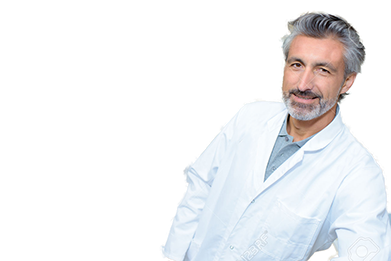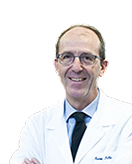

Standing the test of time:
the evolution of surgical mentoring
Mentorship is critical to a surgeon’s professional development, from graduation to retirement. Yet it’s a practice that risks being swept up in the myriad demands of modern medicine. AOSpine explores the benefits and looks to the future
Like many of the central tenets of medicine and indeed modern civilization, the concept of ‘mentor’ actually has ancient roots. The word was first introduced to the English language in Homer’s Odyssey, at the end of the 8th century BC. Preparing to depart for the Trojan War, Odysseus appoints his friend Mentor to look after his son, Telemachus, and his palace. Athena later disguises herself as Mentor and offers advice to Telemachus on finding his father, leading to the modern use of the term to refer to a person who imparts wisdom and practical advice to a less experienced colleague.
 "In spinal surgery, as with almost any medical speciality, it would be virtually impossible to master all the learning, skills and key competencies without some sort of mentorship structure."Read the interview with Ferran Pellisé
"In spinal surgery, as with almost any medical speciality, it would be virtually impossible to master all the learning, skills and key competencies without some sort of mentorship structure."Read the interview with Ferran Pellisé![]()
Though it’s more explicitly referred to in the business world, mentoring is equally central to professional development in medicine and surgery. For centuries medical training centered on apprenticeships, whereby trainee doctors and surgeon would learn ‘on the job’ with a more experienced colleague, until they felt ready to work independently. The system of residency favoured in the USA and much of Europe is thought to have originated with Dr William Stewart Halsted, one of the ‘Big Four’ founding professors of Johns Hopkins Hospital, Baltimore. Appointed Chief of Surgery in 1890, Halsted was a pioneer in antiseptic technique and anaesthetic, but is best known for implementing a model of surgical education that would go unchallenged for more than a century.
Raising the standard of surgical science
The Halsted system was a standardized training programme where trainee surgeons spent six to eight years literally as ‘residents’ of the hospital, forbidden to marry and constantly on-call, routinely working 110-hour weeks. The use of a pyramid structure created a competitive environment whereby the weaker candidates were weeded out and the stronger trainees given increasing levels of responsibility until they emerged as fully qualified surgeons.
According to a 2008 article1 by MG Möller at al in the Bulletin of the American College of Surgeons: ‘Surgeons trained under the Halstedian system learned directly under the professional and technical guidance of their mentors. In William L. Halsted’s own words, this system was intended to “produce not only surgeons but surgeons of the highest type, men who will stimulate the first youths of our country to study surgery and to devote their energies and their lives to raising the standard of surgical science.”’
Changed times
Though the Halstedian model shaped the medical community for more than a century, the 21st century heralded a new approach. The introduction of work week restrictions (limited to 80 hours in America in 2004) aimed to create a safer and more balanced working environment, while the rapid pace of technology meant that the focus shifted towards competency-based lifelong learning, ensuring that even experienced surgeons were able to keep up with new tools and techniques.
‘The modern surgical resident faces a training environment that is adapting to curriculum guidelines, duty-hour regulations, and, in some instances, reformulation,’ write Dr Möller et al. “All of these changes have obligated the mentor-mentee relationship to evolve. Today’s trainees require a more complex approach to mentoring to meet their diverse needs. Besides clinical and surgical skills, surgical trainees must acquire a broad range of technical, interpersonal, administrative, and research skills. Today’s mentors must disseminate their knowledge of and passion for surgery in an environment that bears little resemblance to the one in which they have trained and developed as mentors.’
Paradigm shift
The influence of the mentor on the mentee is not to be underestimated, with one survey of 74 residents revealing that 73% adopted the subspecialty of their mentor2. And yet, says Dr Möller: ‘For residents, mentorship at its most basic level means a relationship with at least one person whose path they would like to follow. For many, the path is forged on the basis of surgical interests; however, the mentor-mentee relationship generally extends well beyond such matters. Mentors not only reflect a passion for a particular surgical field but also reflect an attitude toward work, an approach to work-life balance, a commitment to basic or clinical research, a style of administration, or a devotion to public health.”
Indeed, Professor C Scott Hultman, Chief and Program Director of the Division of Plastic and Reconstructive Surgery at the University of North Carolina, argues there has been a ‘paradigm shift’ away from the old practice of ‘see one, do one, teach one’ towards a more holistic focus on lifelong learning. Reflecting on his own surgical training, Prof Hultman writes: We focused on "seeing cases, doing cases, and teaching cases"… Most of our superiors were not true educators – they did not teach how to learn and neglected to teach the process of learning. Fortunately, early in my training, I met an inspiring, innovative surgical educator… Chip Baker became Chief of Trauma at the University of North Carolina in 1989…. Dr. Baker questioned the process of how we learn and how we teach. Surgery was about problem solving, not just about providing a service or a product. The goal was not to regurgitate facts, but to think about solutions.3”
Seeking role models
This paradigm shift brings with it a new set of qualities for successful mentors and mentees. According to a wide-ranging 2012 literature review by P Entezami et al4, which examined all academic articles on mentoring in surgery published between 1985 and 2010, 82% of articles attempted to summarize the combination of skills and qualities required in surgical mentors. These were: being a professional role model (cited in 58% of articles); willingness to dedicate time and effort to the mentee (48%); an attitude of compassion, kindness and support (39%); participation in critical assessment (32%); being a leader in their field (29%) and challenging the mentee professionally (29%).
Yet despite this lengthy wish list, the majority of surgical mentors today have had no formal training to equip them in their responsibilities. The literature review found that 50% of scholarly articles identified a shortage of mentors due to lack of training. Reinforcing this statistic, a 2015 study of surgical mentoring in the UK and Ireland titled Mentorship in Surgical Training: Current Status and A Needs Assessment for Future Mentoring Programs in Surgery surveyed hundreds of surgeons on the topic of mentoring. It found that while 83% would like to receive mentoring training, only 8.7% reported having received any. The report points out that whilst the Royal College of Surgeons in the UK recognizes the importance of surgical mentoring, there’s currently no dedicated national framework for its provision in the UK and Republic of Ireland.
In the UK, a trainee surgeon might consider their educational supervisor to be a mentor, but no formal procedure or guideline sets out the parameters of that relationship. Similarly, surgical residents in the US benefit from intensive mentoring, but it generally falls to the individual mentor to meet that high bar of expectation, which takes in not only training in clinical and surgical skills, but also a vast range of professional and interpersonal skills.
Thomas R Russell, Executive Director of the American College of Surgeons, states: “Mentors are interested in their trainees not only professionally, but as human beings as well. They promote their trainees’ efforts to balance professional and personal needs and obligations. They are, on multiple levels, a resident’s or a student’s support system and biggest fan.5”
Barriers
Yet myriad institutional barriers might hamper the success of this important relationship. 68% of research papers examined by Entezami et al highlighted time constraints due to busy schedules and working hour regulations as a major challenge to mentoring schemes. Meanwhile, potentially crucial institutional issues included a lack of female mentors, generational differences and cultural differences. The authors point out that these factors influence the relationship between mentor and mentee, and the expectations one might have for the other. For example, the challenges faced by a female surgeon in a male dominated profession might be better understood by a female mentor; the current generation of surgical trainees place a stronger emphasis on work-life balance than their mentors; and sensitivity towards cultural difference is important as the medical environment continues to become more internationally connected. The authors conclude that while mentoring might not always have a structured form, it should not be treated casually.
It seems that while mentorship has been a mainstay of medical training for centuries, the time has come for the practice to be given greater prominence and support. Just as Halsted standardized surgical education, medical bodies in the 21st century may now need to formalize and standardize surgical mentorship. Increasing competition, technological progress and time constraints continue to place immense pressure on surgeons both new and experienced. Without support, it seems there is a real danger that this valuable exchange of knowledge and experience could become a lost art of medicine.
AOSpine Mentorship Education Scheme Launched in New York City!
 Mentoring matters
Mentoring matters
Dr Ferran Pellisé, Director of the Spine Unit at the Hospital Quiron, Barcelona, has more than 20 years’ experience mentoring young surgeons. He shares his perspective on the benefits it brings
What is your experience on mentoring programs, and why do you feel they are important for newly qualified medical professionals?
I joined the Spine Unit at Hospital Quiron in 1995 and have been a mentor throughout that time. We generally have two or three residents at any one time, and we currently have two residents and three students from overseas. I also act as a mentor as part of my role as an Officer of Eurospine. In Spain, mentoring is at the heart of the residency program that every surgeon will go through. You go to a teaching hospital and it’s part of the job you’re paid to do. I’m not aware of any healthcare system in the world in which young doctors go straight from medical school into practice. In spinal surgery, as with almost any medical speciality, it would be virtually impossible to master all the learning, skills and key competencies without some sort of mentorship structure.
In your view, what are the key benefits of mentoring programs?
Mentoring saves time, making the learning process more immediately productive. Generally we learn by trying an approach and failing, then after we fail we analyze what went wrong and take a new path that leads to a better outcome. There’s a lot of trial and error. By contrast, if you have the benefit of an experienced mentor you’re able to base your practice on solid foundations, drawing on their experience. You save time by listening to the experience of others and reading everything you can to consolidate what you have learned. Of course, the quality of the mentor is fundamental to the success of this approach.
What qualities does a mentor need to have?
First of all, they need to have extensive professional experience, so that they offer a sound mechanism and rationale to make good decisions. However, they also have to be willing to teach, to invest their time on providing guidance and helping the mentee to develop. I’ve found that in order to do that properly you have to adopt a process of phased support. In the beginning you spend a lot of time advising and supervising the mentee, then as they grow in confidence you begin to delegate certain responsibilities to colleagues, bringing in more breadth of views and listening to their feedback. There is a progressive transfer of responsibility, until by the end of the process the junior surgeon has the confidence to take control of their own practice and work independently. However it’s crucial that you continue to steer them towards their goals.
Does your hospital have a formal mentoring program that’s followed or is there flexibility in the approach?
We have a basic program which is adapted to suit the experience and personality of the student or fellow. Each junior surgeon has a unique background that we need to take into account. They might be used to working in a different setting, or they could have already been working in our hospital for many years. There could be language or cultural barriers to consider too. This can make mentoring an overseas student more challenging but that entirely depends on the individual – I have had some international students who were simply brilliant, and that compensates for any initial communication difficulties.
What qualities does the young surgeon need to make the mentoring relationship successful?
They must be willing to learn – after all, this isn’t school, they’re coming here on a voluntary basis. You need to have a spinal fellow who wants to learn, and it’s very rare for us to encounter someone who doesn’t have enthusiasm for that.
You explained that mentoring saves ‘trial and error’ for the mentee. How do you ensure that they still feel able to challenge decisions and ask questions?
They challenge me constantly! In the beginning they tend to be quite quiet, but as their confidence grows they frequently ask ‘Why not do it the other way?’ I see that as a very positive thing, and I do sometimes change my mind about an approach after listening to alternative ideas. Even though mentors are more senior, someone with less experience may still be right. It’s important that we remain flexible and sensitive to good ideas.
Is that openness something that needs to be nurtured throughout a surgeon’s career?
Absolutely, and it’s worth remembering that mentorship doesn’t end after the residency program. It’s something that you maintain throughout your career. I have colleagues who are 5 to 15 years older than me and I still talk to them and learn from them all the time. I meet each month with other spinal surgeons from my own hospital and others, and we discuss cases and assist in surgeries as required. If you can build solid human relationships at the start then you have professional mentors for life.
Dr Ferran Pellisé is an experienced traumatologist and orthopaedic spine surgeon, leading the Spine Unit at the Hospital Quiron, Barcelona, since 1995. He specializes in the surgical treatment of deformities, tumors, fractures, infections and spinal pathologies. Dr Pellisé has published more than 70 papers in international journals and led on numerous research projects. He is an active researcher at the Vall d’Hebron Research Institute and a member of Eurospine. Dr Pellisé also works as a volunteer doctor in Ghana through the FOCOS Foundation.
- Möller MG, Karamichalis J, Chokshi N, Kaafarani H, Santry HP. ‘Mentoring the modern surgeon’. Bulletin of the American College of Surgeons July 2008. http://www.aats.org/multimedia/files/Mentoring-Modern-Surgeon-ACS.pdf
- McCord JH, McDonald R, Leverson G, et al. Motivation to pursue surgical subspecialty training: Is there a gender difference? Journal of the American College of Surgeons. 2007; 205 (5):698-703. http://www.aats.org/multimedia/files/Mentoring-Modern-Surgeon-ACS.pdf
- Hultman CS. ‘The (R)Evolution of Surgical Education in the Twenty-first Century: Replacing the Traditional Paradigm of "See One, Do One, Teach One" With Competency-Based, Lifelong Learning.’ Plastic Surgery Pulse News. http://www.plasticsurgerypulsenews.com/4/article_dtl.php?QnCategoryID=39&QnArticleID=97&QnCurPage=1
- Entezami P, Franzblau L, Chung K. ‘Mentorship in surgical training: a systematic review’ 2012. http://www.ncbi.nlm.nih.gov/pmc/articles/PMC3280364/
- Möller MG, Karamichalis J, Chokshi N, Kaafarani H, Santry HP. ‘Mentoring the modern surgeon’. Bulletin of the American College of Surgeons July 2008. http://www.aats.org/multimedia/files/Mentoring-Modern-Surgeon-ACS.pdf p22
Share this article